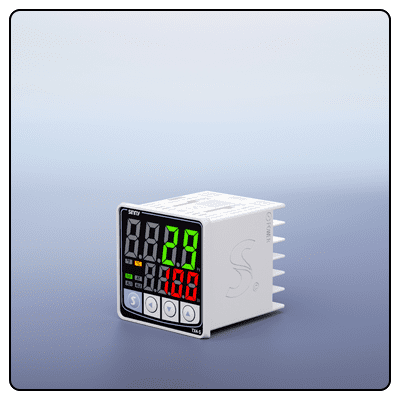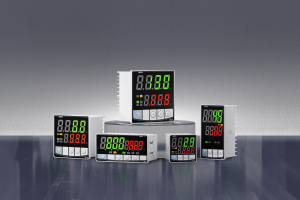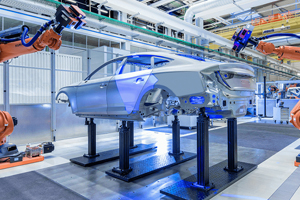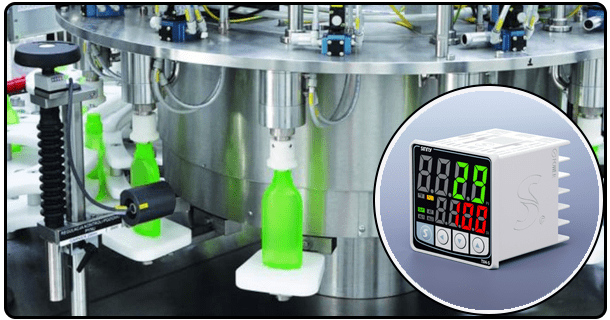What is PID temperature controller?
1. Introduction

Temperature regulation is a basic requirement for a wide range of applications in industrial, scientific, and commercial settings. Stable thermal conditions are not just a choice, but a requirement for many applications. They can ensure operational efficiency, protect the integrity of products or materials, meet safety regulations, optimise energy usage, etc. The ubiquitous on/off thermostats are not able to satisfy the needs of today's applications that require fine control and stabilty. To overcome these constraints, sophisticated control strategies have been developed, among which the Proportional-Integral-Derivative (PID) control algorithm stands as a cornerstone. This device, the PID temperature control, implements this algorithm and offers an effective, reliable solution to temperature regulation problems. The article will provide an in-depth exploration of what a PID controller is, using as its main focus a PID controller that regulates the temperature inside a small enclosure. This article will provide a detailed exploration of the meaning of a PID temperature controller, using as its central focus a specific example designed to regulate the internal temperature in a small electronic enclosure. By dissecting and examining this particular example, describing its operation in a closed loop system, illustrating it application and discussing its tuning process, you can gain an in-depth and tangible understanding on how a PID works in practice. It is the goal to provide a detailed and clear exposition which meets the E-E-A.T (Expertise, Expertise and Authoritativeness) criteria in the area of temperature control and control systems.
2. The PID Algorithm: Proportional-Integral-Derivative Explained
PID is the intellectual core of sophisticated temperature controls. The PID algorithm's core function is to calculate a correction based on comparing the measured and desired state of the system. The corrective action's goal is to minimize the difference, also known as error signal. Examining the PID's constituent parts will help us understand the algorithm better.
The error signal is firstly derived by a very simple but crucial comparison. Setpoint is the desired temperature of the system. The user can set a target temperature. The Process Variable is also important, as it is the temperature that is currently being measured by the sensor in the system. The difference between Setpoint and Process Variable is the error signal: Error = Setpoint-Process Variable. This error's magnitude and signal determine the corrective actions.
PID calculates corrective actions based on three components that each contribute to a particular aspect of control.
Proportional Term (P): This term produces a control signal that is directly proportional the magnitude of the error signal. This can be mathematically expressed by P_output = Error * Kp, where Kp is the proportional gain. This proportional gain is what determines the strength of the response to an error. The proportional gain increases with a larger error, and vice-versa. P-term's primary function is to reduce the error immediately. It often results in residual errors; for example, the system may not achieve the setpoint exactly and continue to drift.
Integral Term (I): This term refers to the accumulation of errors over time. The error signal is integrated over time, usually represented by I_output=Ki * Errordt where Ki represents the Integral Gain. The I term continuously sums up the error signal. The primary goal of the I term is to remove steady-state errors, the little error left by the P-term. The I term increases its output if the error continues, no matter how small. This will drive the actuator to try and remove the error. The I term has a significant disadvantage if there is recurrent error (such as oscillating at the setpoint) because the integral can lead to overshoot or instability.
Derived (D) Terms: This term is based on the rate at which the error signal changes. The derivative is calculated (d(Error/dt), and an output generated that counters rapid changes. Mathematically D_output is equal to Kd* d(Error/dt), where Kd represents the derivative gain. D acts as a dampening force. The D term predicts errors in the future based on current trends and smooths out the control signals. The anticipation reduces oscillations which may occur when the P or I terms are overly aggressive and cause the temperature to fluctuate excessively between the setpoint and the outside. D-term also helps to speed up the initial response because it anticipates the need for corrections before they become large. The D term is sensitive to the noise that can occur in an error signal and could cause the controller to act erratically.
This three-term combination is usually done by adding them up to create the final signal. The actuator receives this signal to perform the required action. It is important to balance the P, D, and I terms and tune them in order to achieve the required level of stability and accuracy.
3. What is the difference between "controller" and "temperature"?
A. The "Controller", in its simplest form, is a device which compares the state of the system with the desired state. It then adjusts outputs to minimize the differences between the two states. The controller is used to monitor temperature levels and regulate heating or cooling in order to reach the desired temperature.
B. Temperature is the measure of how hot or cold a substance is, usually using a temperature sensor. It is the measurement that the PID system uses to regulate the temperature of the process.
The "PID temperature controller" is therefore a combination of these concepts. It uses the PID algorithms, which are implemented in a control unit, to compare a measured temperature (the variable process) with a setpoint temperature and then adjusts the heating element or cooling device (the actuator), accordingly, to maintain that temperature.
4. The Key Components in a PID Controller
While the complexity of a PID system can vary, it usually involves several components that work together. It is important to understand these components in order to fully grasp the meaning and purpose of the PID temperature controller.
B. Interface for Temperature Sensor: The component responsible for measuring a process variable, the temperature of the system. It is important that the sensor has high accuracy and reliability. The most common types are thermistors (also known as Resistance Temperature Detectors or RTDs), thermocouples and digital sensors such as the DS18B20. Selecting the sensor depends on its temperature range, accuracy and application. Typically, it connects with the controller logic via digital interfaces such as 1-Wire and analogue signals.
The PID controller's brain is C. Comparer / Controller logic: The primary function of the controller is to calculate and use the error signal, which is the difference between the setpoint temperature and the process variable. It contains software or hardware that calculates the integral, derivative, and proportional terms, then combines them into the final control signal. This logic can be implemented in a microcontroller.
Actuator An actuator is a device that takes the control signal from the logic controller and affects directly the variable of the process (temperature). It is the actuator's responsibility to carry out the PID algorithm-calculated corrective actions. Solid State Relays are commonly used in temperature control systems to switch heating or cooling elements. Mechanical Relays can also be used, but SSRs tend to be preferred because of their fast switching speeds and lack of moving parts. Controller sends specific signals to actuators. This could be Pulse Width Modulation signal (PWM), direct voltage/current signal or switch signal control an SSR. The actuator controls the amount of power that is delivered to the cooling or heating element.
5. Closed-Loop Control System
Closed-loop systems use feedback to control the process variables. Closed-loop systems are often exemplified by the PID temperature control.
B. This operation is performed as follows: the temperature sensor sends the information about the temperature to the logic controller. This measurement is compared to the setpoint temperature by the controller. This difference is called the Error signal. This error signal is processed by the PID algorithm, which generates a corrective response. The actuator then adjusts heating or cooling. The sensor measures the new temperature after the adjustment, and this is used to provide feedback. This new information is used by the controller to determine the next correctional action. The cycle then continues. The system adjusts constantly to the temperature desired by using this closed-loop.
Closed-loop systems are used to create a feedback loop in a PID controller. The controller continuously compares the temperature of the process variable (the setpoint) with the temperature that is desired (the actual temperature) and adjusts the heater/cooler (actuator), to reduce the error.
6.Useful Application Examples: Meaning
Let's look at a simple case to better understand what a PID controller is: it regulates the temperature in a small enclosure.
B. Imagine that a small electronic enclosure contains sensitive components which are damaged by heat. Setpoint is set at 50degC. A DS18B20 is used by the controller to determine internal temperature. Sensor data is sent to the logic of controller (e.g. a microcontroller). Microcontrollers calculate the error. (current temperature less 50degC). Based on the error, PID calculates P, I and D terms. This controller produces a PWM to represent the corrective action calculated (e.g. increasing heating power). The PWM control signal adjusts the heating element 12V connected to enclosure using an SSR. This system measures temperature continuously, calculates error and then adjusts heating power. The closed-loop system ensures that the temperature inside the device stays near 50degC. This is a good example of how a PID controller works. It continuously adjusts an actuator (heating component) in order to maintain the set temperature.
In this example, the PID controller is clearly defined: It is a PID system which uses Proportional Integral and Derivative Terms to determine the required adjustment for the heating element. This is done by using a continuous feedback loop to measure the temperature of the heater and compare it with the setpoint. The temperature can be accurately and consistently regulated within the enclosure.
7.The Advantages of using a PID temperature controller
The PID controller is a popular choice in many applications that require precise temperature control.
B. These advantages are based on the PID algorithm's ability to manage the error signal and provide the following benefits.
C. Accuracy: Because the PID algorithm can calculate corrective actions based on errors, it is able to regulate temperature very accurately. High accuracy means that the controller is able to maintain the process variables very near the setpoint. The PID term is used to achieve this: the P-term provides an immediate correction that's proportional with the error. The I-term eliminates the steady state error over time. And the D-term anticipates the changes and prevents overshoots and oscillations. High accuracy means that the controller is able to maintain temperature within tight tolerances. This is crucial in protecting sensitive components, and for ensuring reliable operations.
Stable operation: The D-term in the PID algorithm helps to prevent oscillations. Stable operation means that the system settles at the presetpoint, without any excessive cycles or fluctuations. The D-term dampens response and anticipates changes, preventing the system to swing wildly. Stable operation means that temperature can be maintained predictably and reliably.
Energy efficiency: PID algorithms provide precise controls that allow the controller to precisely adjust heating power. Energy efficiency means that the controller only applies the power required to achieve and maintain the desired temperatures. The system reduces energy usage by avoiding unnecessary heating. Energy efficiency means that the system reduces waste energy.
F. Reliability : The definition of reliability is the ability to perform your function consistently over time. This meaning is influenced by the components selected for the controller. This is the meaning of reliability: that the system will provide dependable temperature regulation.
Flexibility This refers to the fact that the controller is adaptable for different applications, by changing its sensor, actuator and setpoint. Flexibility is the ability to use the controller in different scenarios that require temperature regulation.
- Tuning Guide & Troubleshooting
- Understanding a PID Temperature Controller Example: A Practical Guide






















